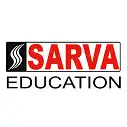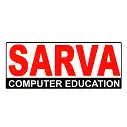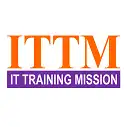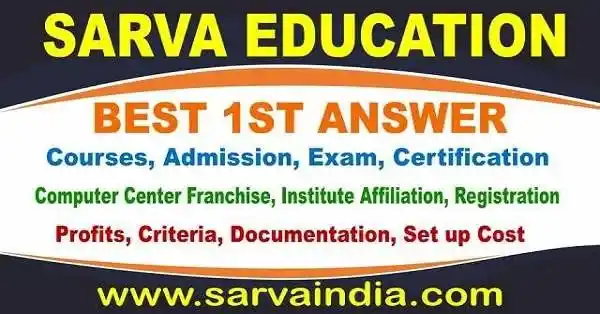
Here's an ADCA 1 Year Course Question Paper Sample For Computer Training Institute. Each section is allocated a specific number of marks.
Computer Education Centre can copy, edit & Download Free Advance Diploma in Computer Application-ADCA Diploma or Certificate Course Question Paper Sample in PDF or Word Format.
Copy and Download Below shown ADCA Course Question Paper in PDF, Word, Doc and Docx File Format-
ADCA Course Question Paper Format Sample
ADCA-Paper-1
Title- Basic Computer, MS Office and Internet
Time- 3 Hours Minimum Marks: 35 Maximum Marks: 100
Section A: Basic Computer (30 Marks)
Question 1 (10 Marks): Multiple Choice Questions (MCQs)
1.1. What does CPU stand for? a) Central Processing Unit (b) Computer Processing Unit (c) Central Processor Unit (d) Central Printed Unit
1.2. Which of the following is not a type of computer memory? a) RAM b) ROM c) CPU d) Cache
1.3. What is the primary purpose of an operating system? a) Run applications b) Manage hardware resources c) Connect to the internet d) Print documents
1.4. Define the term "GUI." a) Graphical User Interface b) General User Interface c) Graphical Unit Interface d) General Unit Interface
1.5. What is the binary equivalent of the decimal number 25? (a) 10011 (b) 11001 (c) 11101 (d) 10100
Question 2 (10 Marks): Short Answer Questions
2.1. Explain the difference between hardware and software.
2.2. Briefly describe the function of an input device and provide an example.
2.3. What is a file extension? Give an example.
2.4. Differentiate between a virus and malware.
2.5. What is the purpose of the BIOS in a computer system?
Question 3 (10 Marks): Practical Application
3.1. Open the Notepad application and type a short paragraph. Save the file with an appropriate name and location.
3.2. Create a new folder on the desktop and name it "MyDocuments." Move the paragraph file created in 3.1 to this folder.
3.3. Take a screenshot of the desktop and save it as "DesktopScreenshot.png" on the desktop.
Section B: MS Office (40 Marks)
Question 4 (15 Marks): Microsoft Word
4.1. Create a new document in Microsoft Word. Insert a table with 3 rows and 4 columns. Populate the table with any data.
4.2. Apply different formatting styles (bold, italic, underline) to the text in the second row of the table.
4.3. Insert a header with your name on the right side of the document.
Question 5 (15 Marks): Microsoft Excel
5.1. Open Microsoft Excel and create a new spreadsheet. Enter some numerical data in columns A and B.
5.2. Calculate the sum of the numbers in column B and display the result in cell C1.
5.3. Create a bar chart to represent the data in columns A and B.
Question 6 (10 Marks): Microsoft PowerPoint
6.1. Create a new PowerPoint presentation with three slides.
6.2. On the first slide, insert a title "Introduction to Computers."
6.3. Add a bulleted list on the second slide with key points about the importance of the Internet.
Section C: Internet (30 Marks)
Question 7 (10 Marks): Internet Basics
7.1. Define the term "URL" and provide an example.
7.2. Explain the difference between a website and a web page.
7.3. What is the purpose of a web browser? Name two popular web browsers.
Question 8 (10 Marks): Online Communication
8.1. Describe the difference between email and instant messaging.
8.2. Explain the concept of social networking and provide an example.
8.3. How does a search engine work? Name one popular search engine.
Question 9 (10 Marks): Internet Safety and Security
9.1. List three tips for ensuring online safety.
9.2. What is phishing, and how can users protect themselves from it?
9.3. Briefly explain the importance of using strong passwords.
ADCA-Paper-2
Title- Tally Prime, HTML, DHTML & C Programming
Time- 3 Hours Minimum Marks: 35 Maximum Marks: 100
Section A: Tally Prime (30 Marks)
Question 1 (10 Marks): Multiple Choice Questions (MCQs)
1.1. What is Tally Prime used for? a) Graphic Design b) Accounting and Finance c) Web Development d) Word Processing
1.2. Define the term "ledger" in Tally.
1.3. How can you create a voucher in Tally Prime?
1.4. Explain the purpose of the GST (Goods and Services Tax) feature in Tally Prime.
1.5. What is the function of the "Balance Sheet" in Tally Prime?
Question 2 (10 Marks): Short Answer Questions
2.1. Differentiate between a group and a ledger in Tally.
2.2. Explain the steps to view the Profit and Loss statement in Tally Prime.
2.3. What is the significance of the "Gateway of Tally"?
2.4. How can you reconcile bank transactions in Tally Prime?
2.5. Describe the purpose of the "Day Book" in Tally.
Question 3 (10 Marks): Practical Application
3.1. Create a new company in Tally Prime and enter basic company information.
3.2. Record a sales voucher for a hypothetical transaction.
3.3. Generate a Balance Sheet and Profit and Loss statement for the company created in 3.1.
Section B: HTML and DHTML (30 Marks)
Question 4 (15 Marks): HTML
4.1. Create an HTML document with a title "My Web Page."
4.2. Design a webpage that includes a heading, paragraph, and an ordered list.
4.3. Insert an image into the HTML document and provide alternative text.
Question 5 (15 Marks): DHTML
5.1. Explain the difference between HTML and DHTML.
5.2. Develop a simple DHTML script that changes the color of a paragraph when the mouse hovers over it.
5.3. Implement a DHTML feature that hides and shows a div element when a button is clicked.
Section C: C Programming (40 Marks)
Question 6 (15 Marks): Basics of C Programming
6.1. Define the terms "variable" and "constant" in C.
6.2. Write a C program to find the sum of two numbers entered by the user.
6.3. Explain the purpose of the "if-else" statement in C.
Question 7 (15 Marks): Functions and Arrays in C
7.1. Create a C function that calculates the factorial of a given number.
7.2. Write a C program that uses an array to store and display the names of three students.
7.3. Explain the concept of a function prototype in C.
Question 8 (10 Marks): Pointers in C
8.1. Define a pointer in C and explain its significance.
8.2. Write a C program that uses pointers to swap the values of two variables.
8.3. Discuss the advantages of using pointers in C programming.
Note: Above Mentioned Detail For "ADCA Course Question Paper Sample" is based upon inquiries or questions asked or searched by people over the internet. Herein, we are trying to provide the best answers, suggestions, ideas, tips, process, and explanations for informational purposes in the public interest. Always consult with experts and competent authorities before making any decisions.
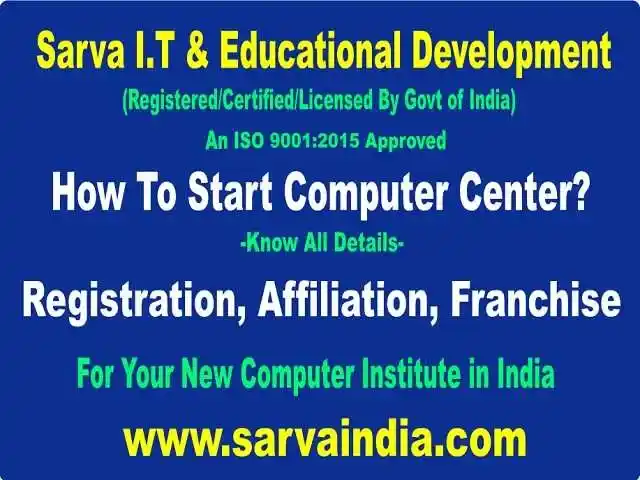
Apply For Starting A New Computer Training Centre in India
Apart From Above Answer you may also check below mentioned Details To Start, Open new computer Software Center, Typing Course Academy and Hardware Networking Coaching Institute in non formal training sector with low investment under Self employment I.T Training Mission of Sarva Education (SITED), which is registered and Licensed by Govt of India.
Contact Here! To Start New Computer Training Centre!
Our Newly Recognised Computer Education Institute will get Free Centre Start up Business Kit and free of cost ebooks notes created by our expert team on various topics for starting/imparting quality education in your study centre.
Register to Start/Open an Affiliated Computer Institute with Sarva Education (SITED), License Granted by Govt of India, Vide LIC. No.2/114/T-1/08/D, Read with notification No. GSR 288(E) dated 31.5.1991 of Govt. of India, Ministry of Law, Justice & Department of CA, under CRN/MCA: U72900HP2008NPL030981. Having prestigious International ISO 9001:2015 Certification for its Quality Management System.
Government of India Registration Certificate of Pledges: Under Ministry of youth and Sports, National Human Right Commission, Central Vigilance Commission. Other Registrations- Niti Aayog, Govt India/NGO Darpan etc.
Franchise Network of 3045+ Affiliated Computer Education Training Centers all over India. IAF/ABCB/ICM/ISO Recognised Organization. A Trustworthy Reputed No.1 Best Autonomous Organization For I.T, HRD Literacy Work.
Active Since 2008, Sarvaindia.com website Domain registered in 2010. All over India territorial jurisdiction.
Document Requirements and Norms To Start, Open, Register A New Computer Training Center Institute in any part of India-
- To Register Center, you must be above 18 Years
- Minimum Qualification 10Th Pass
- Your 2 Passport Size Photos Require
- Your Aadhaar Card, Voter Card Copy
- Qualification Copies Require
- All Documents attested by Gazetted Officer
- Self Signed Up Institute Application Form
- Now Email and Post All Documents
Infrastructure or Set up needed to affiliate your Computer Institute-
- 3 Computer System Require
- 1 Room (Min.100 Sq. Ft)
- 6 to 12 Chairs
- 1 Printer (Color or B/W)
- Internet connection
- 3 Computer Tables
- One Time Small Centre Registration Fee
- Attach Fee Screenshot with center application form.
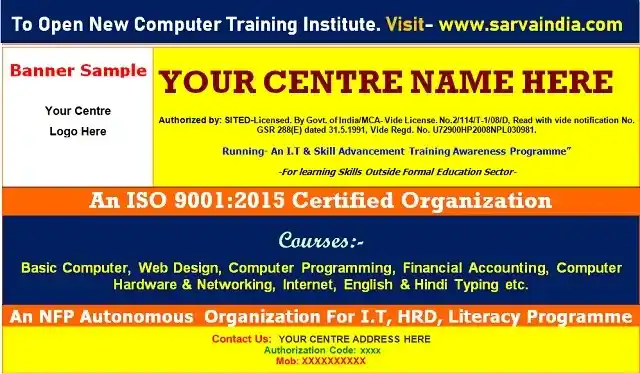
Prescribed Simple and Fast steps Criteria To get franchise for Computer Institute Center, Follow all specified steps-
1st Step- Fill up Online New Centre Inquiry Form.
2nd Step- Thereafter we will reply to your inquiry by call or by sending offer details and Centre application form at your email, you can Check Your Email within 12 hours.
3rd Step- After downloading the Institute Registration Application Form- Take Print out and Fill up Required Details. Use Capital Letters in the Application Form.
4th Step- Attach Following Documents along with Centre Application Form- Your Color Photo, Last Qualification Copy, Aadhaar Card Or Voter Id Cards Etc.
5th Step- For Fast Centre Activation Process- Send Complete Centre Application Form Along With Centre Authorization Fee Transfer Details Like Bank Receipt Or Screenshot Or Bank Transaction ID Number Or UTR Number Via Email At- sarvaeducation@gmail.com. Also Type Your Name, Centre Name, Centre Address, and Mob. Numbers in Email.
Note- If You Have Already Started Your Center, Then, You Have To Take a Snap, By Using Your Smart Phone Of Centre Building Front, Centre Room/S, Or Send The Same Via Email Within 2 Months, After Getting Centre Authorization*.

Quick Timing Prescribed For accreditation and Activation of Your Low Cost New Computer Center-
- Head Office will activate your centre code within 6 to 24 hours.
- After Activating your Center, Head Office will send Congratulation Email along with details of your Active Centre Code, User Login ID, Password and Soft Copy of Centre Authorization certificate.
- Thereafter, head office will send welcome centre kit by Speed post, which includes hard copies of Posters, Student ID Card, Prospectus, Admission Forms and Centre Authorization Certificate etc. at your centre address or permanent address.
Register Now- Checkout the benefits provided to you by Sarva Education:
- You Have Right to Create and Modify Courses as per present, future market trends.
- Free Centre Start up Kit includes Prospectus, Admission Forms, ID Cards, Posters, Brochures, and Authorization Certificate etc.
- New Admission Enquiries from your local Area will be provided to your center, through online Google ads or Our Website's SEO.
- Admission Fee, Monthly Fees and Exam fee of courses will be decided by Centre Owner.
- Head Office has No Sharing in Admission Fee, Monthly Fees and Exam Fee of Courses.
- Mode of Student Training and Exam- Regular, Correspondence and Online Available.
- Right to Edit and Set Offline or Online Papers, as per your courses syllabus.
- Right to conduct Offline or Online Exams in your centre.
- Right to Add, Upload Student Certificates, Result at head office website.
- ISO 9001:2015 Certified Quality Management system.
- Online Centre Profile and Student Profile viewing facility.
- Right to use Sarva Education Brand Name, with your institute name.
- Free ebooks available for all Subjects.
- Job Assistance for deserving Students.
- Participation opportunity will be provided to center, Whenever govt. project and schemes taken by SITED.
Admission Advantages For Students
- Free Prospectus cum Brochure
- Free Student ID-Card
- Free Admission Form
- Free ebooks For All Courses
- Online Roll Number Verification
- Online Student Photo Verification
- On Online Exam Login Panel For Student
- Option For Online Exams At Head Office Website
- Option For Offline Exam At Your Center
- Job Assistance For Deserving Students
- Verify Certificate with Hologram/QR Code
- Get Certificate within 10 to 20 Days At Centre Address
- Online Result, Certificate Verification.
FAQs on Sarva Computer Training Centre Franchise, Affiliation and Registration
Q1. Why choose Sarva Education for opening a computer training center in India?
Ans: Sarva Education is a government certified organization with ISO 9001:2015 certification, offering trusted and proven support to start your own training institute anywhere in India.
Q2. What makes Sarva Education the No.1 computer institute franchise in India?
Ans: With 3045+ successful centers and a national brand presence, Sarva Education leads in digital literacy and skill development, providing unmatched training content, certification, and guidance.
Q3. Is Sarva Education a low-investment, high-return franchise opportunity?
Ans: Yes, Sarva Education offers the most affordable franchise model in India, starting at just ₹4500, with no royalty on student fees and free e-learning materials.
Q4. What kind of support does Sarva Education provide to new centers?
Ans: Affiliated centers get full support including startup kit, center management panel, marketing templates, online training material, certification, and advertising assistance.
Q5. Does Sarva Education offer branding and promotional help?
Ans: Yes, Sarva Education allows you to use its nationally and internationally recognized No.1 brand name and provides promotional designs, SEO support and visibility on the official website.
Q6. How is Sarva Education better than other computer institute franchises?
Ans: Unlike others, Sarva Education has transparent policies, zero royalty, fast certificate delivery and government certifications, making it the most trusted choice in India, since 2008.
Q7. Can Sarva Education centers participate in government skill development projects?
Ans: Yes, Sarva-affiliated centers are eligible to participate in government and non-government projects if granted to Sarva Education nationally.
Q8. Is the affiliation process easy and fast with Sarva Education?
Ans: Absolutely. The online registration process is quick, with minimal documentation and you can receive approval and start within 3–5 working days.
Q9. What types of courses can I offer through a Sarva Education center?
Ans: You can run certified computer education, skill development, English speaking, personality development and job oriented programs under one roof.
Q10. Why is Sarva Education ideal for rural and urban entrepreneurs?
Ans: Sarva Education empowers both rural and urban areas with flexible, low cost and high impact franchise options backed by national level credibility and technical support with 16+ experience
Computer education Courses you can run in your institute-
- You have full right to update or edit Subjects of non formal training courses and Add New Courses as per present, future demand of job market and Industry trends.
- Courses Admission Fee, Monthly Fees and Exam Fee Will be decided By You, We have No Sharing in Said Fees.
- Mode of Student Training and Exam- Regular, Correspondence and Online Available.
Recognised Computer Software Courses List
- PG Diploma In Computer Skills (PGDCS) Eligibility- Graduation, Duration- 1 Year
- Diploma In Computer Instructor Training Skill (DCITS) Eligibility- Minimum 12th, Duration- 1 Year
- Advance Diploma in Computer Programming (ADCP) Eligibility- Minimum 12th, Duration- 1 Year
- Honours Diploma in Computer Skills (HDCS) Eligibility- Minimum 12th, Duration- 1 Year
- Diploma In Computer Office Management and Publishing (DCOMP) Eligibility- Minimum 10th, Duration- 1 Year
- Advance Diploma in Computer Application (ADCA) Eligibility- Minimum 10th, Duration- 1 Year
- Advance Diploma in Financial Accounting (ADFA) Eligibility- Minimum 10th, Duration- 1 Year
- Advance in Diploma in Artificial Intelligence (AI) Skills (ADAIS) Eligibility- Minimum 10th, Duration- 1 Year
- Diploma in Financial Accounting (DFA) Eligibility- Minimum 10th, Duration- 6 Months
- Diploma in Artificial Intelligence (AI) Skills (DAIS) Eligibility- Minimum 10th, Duration- 6 Months
- Diploma in Desktop Publishing (DDTP) Eligibility- Minimum 10th, Duration- 6 Months
- Diploma in Web Designing (DWD) Eligibility- Minimum 10th, Duration- 6 Months
- Diploma in Computer Application (DCA) Eligibility- Minimum 10th, Duration- 6 Months or 1 Year.
- Advance Certificate in Computer Skills (ACCS) Duration- 1 Year
- Certificate in Computer Skills (CCS) (Duration- 1/2/3/6 Months)
- Certificate in Computer Application (CCA) (Duration- 1/2/3/6 Months)
- Certificate in Basic Computer (CBC) (Duration- 1/2/3/6 Months)
- Certificate in Computer Financial Accounting (CCFA) (Duration- 1/2/3/6 Months)
- Certificate in Computer English Typing (Duration- 1/2/3/6 Months)
- Certificate in Computer Hindi Typing (Duration- 1/2/3/6 Months)
- Certificate in Computer Punjabi Typing (Duration- 1/2/3/6 Months)
- Certificate in Computer Marathi Typing (Duration- 1/2/3/6 Months)
- Certificate in Computer Bengali Typing (Duration- 1/2/3/6 Months)
- Certificate in Computer Kannada Typing (Duration- 1/2/3/6 Months)
- Certificate in Computer Telugu Typing (Duration- 1/2/3/6 Months)
- Certificate in Computer Tamil Typing (Duration- 1/2/3/6 Months)
- Certificate in Computer Oriya Typing (Duration- 1/2/3/6 Months)
- Certificate in Malayalam Typing (Duration- 1/2/3/6 Months)
- Certificate in Internet Application (Duration- 1/2/3/6 Months)
- Certificate in Web Designing (Duration- 1/2/3/6 Months)
- Certificate in Basic Computer (Duration- 1/2/3/6 Months)
- Certificate in CompuFunda for kids (Duration- 1/2/3/6 Months)
- Certificate in Accounting (Duration- 1/2/3/6 Months)
- Certificate in Computer Programming (Duration- 1/2/3/6 Months)
- Certificate in Digital Marketing (Duration- 1/2/3/6/12 Months)
- Certificate in Artificial Intelligence (AI) (Duration- 1/2/3/6/12 Months)
- Certificate in Cyber Security Skills (Duration- 1/2/3/6/12 Months)
- Certificate in Data Analyst Skills (Duration- 1/2/3/6/12 Months)
Approved Hardware Networking Courses List
- Diploma in Computer Software and Hardware Skills (DCSHS) Eligibility- Minimum 10th, Duration- 1 Year
- Advance Diploma in Computer Hardware Skills (ADCHS) Eligibility- Minimum 10th, Duration- 1 Year
- Advance Diploma in Computer Hardware and Networking Skills (ADCHNS) Eligibility- Minimum 10th, Duration- 1 Year
- Diploma in Computer Hardware Skills (DCHS) Eligibility- Minimum 10th, Duration- 6 Months
- Diploma in Computer Networking Skills (DCNS) Eligibility- Minimum 10th, Duration- 6 Months
- Certificate In Computer Hardware and Peripherals (CCHP) Duration- 6 Months
- Certificate in PC Assembling and Maintenance (CPCAM) Duration- 6 Months
- Certificate in Computer Soft and Hard Skills (Duration-1/2/3/6 Months)
- Certificate in CPU Repairing (Duration-1/2/3/6 Months)
- Certificate in Monitor Repairing (Duration-1/2/3/6 Months)
- Certificate in UPS Repairing (Duration-1/2/3/6 Months)
- Certificate in Printer Repairing (Duration-1/2/3/6 Months)
- Certificate in Software Installation (Duration-1/2/3/6 Months)
- Certificate in PC Assembling (Duration-1/2/3/6 Months)
- Certificate in Mobile Repairing (Duration-1/2/3/6/12 Months)
- Certificate in Multimedia (Duration-1/2/3/6 Months)
Certified Skill Advancement Centre Courses List
- Diploma in Dress Design Skills (DDDS) Eligibility- Minimum 10th, Duration- 1 Year or 6 Months.
- Courses Without Eligibility
- Certificate in Dress Design Skills (CDDS) Duration- 6 Months
- Certificate in Dancing Skills (Duration- 1/2/3/6 Months)
- Certificate in Mehandi Designing Skills (Duration- 1/2/3/6 Months)
- Certificate in Music Skills (Duration- 1/2/3/6 Months)
- Certificate in Beautician Skills (Duration- 1/2/3/6/12 Months)
- Certificate in Spoken English (Duration- 1/2/3/6/12 Months)
- Certificate in Personality Development (Duration- 1/2/3/6 Months)
- Certificate in Stenography Skills (Duration- 1/2/3/6/12 Months)
Admission and Examination System in Sarva Franchise Training Center-
- Centre Owner is free to take admission and conduct examinations whole year as per duration of courses and prescribed session.
- After conducting examination- Centre Owner will receive concerned student Diploma, Certificates, Mark sheet hard copies at his/her centre address via Registered post within 10 to 20 daysfrom Head Office.
More Details Click Here To Fill Up New Center Inquiry Form
Legal Warning
Do not Copy this page contents because it has been copyrighted by Sarva Education (SITED), if the same contents find anywhere on the internet or on printed/digital material, then, legal action will be taken against Misuser under Copyright laws of India and as per DMCA Act. Our I.T and legal Cell Experts Team easily find stolen contents, which have been copied from of our website or email. We have already initiated legal action against those who had copied contents from our website and email. Already lots of websites have been complained by us and blocked under applicable copyright Act/s for copying this page contents. So, if you are thinking to copy the contents of our website for personal gain, without our authorization, then avoid it, otherwise, ready to face legal action for copyright infringement. All training courses are being run outside formal education sector. Thanks for visiting this page!











